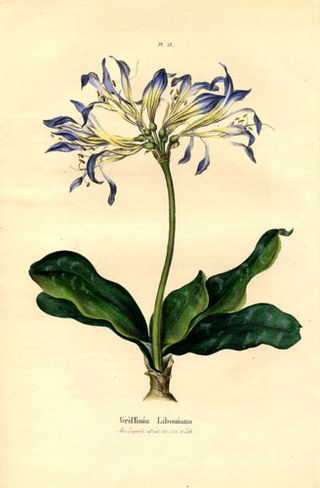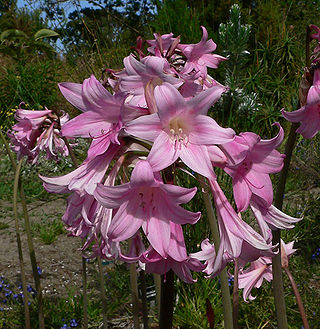
The flowering plant genus Ipheion belongs to Allioideae, a subfamily of the family Amaryllidaceae. It includes three species native to southern Brazil, northeastern Argentina, and Uruguay.

Eucrosia is a genus of herbaceous, perennial and bulbous plants in the Amaryllis family distributed from Ecuador to Peru. The name is derived from the Greek eu, beautiful, and krossos, a fringe, referring to the long stamens. As circumscribed in 2020, the genus contains six species. Phaedranassa and Rauhia are the genera most closely related to Eucrosia.

Phaedranassa is a genus of South American and Central American plants in Amaryllis family, subfamily Amaryllidoideae.

Rhodophiala was a genus of herbaceous, perennial and bulbous plants in the Amaryllis family. It consisted of about 30 South American species distributed in southern Brazil, Argentina, and, specially, in Chile. Most of the species are known colloquially as añañuca. It has now been submerged in Zephyranthes.

The Griffineae is a tribe in the family Amaryllidaceae, subfamily Amaryllidoideae. It includes 3 genera with 22 species endemic to Brazil in South America. A typical character of the representatives of the tribe are the flowers - They are blue or lilac and collected into an umbel. Only the members of this tribe and the genus Lycoris are able to form flowers with such color in the whole subfamily Amaryllidoideae of Amaryllidaceae. The species in this group are typically perennial and produce bulbs. The leaves are green, with elliptical form in most of the cases but in some members, as in Worsleya, they are sword-shaped.
Eucrosia eucrosioides is a species of flowering plant in the family Amaryllidaceae. It is found in south west Ecuador and north Peru. Its natural habitats are seasonally dry lowland areas.

The Amaryllidaceae are a family of herbaceous, mainly perennial and bulbous flowering plants in the monocot order Asparagales. The family takes its name from the genus Amaryllis and is commonly known as the amaryllis family. The leaves are usually linear, and the flowers are usually bisexual and symmetrical, arranged in umbels on the stem. The petals and sepals are undifferentiated as tepals, which may be fused at the base into a floral tube. Some also display a corona. Allyl sulfide compounds produce the characteristic odour of the onion subfamily (Allioideae).

Pyrolirion, commonly known as fire lilies or flame lilies, is a small genus of herbaceous, bulb-forming South American plants in the Amaryllis family, native to Chile, Peru, and Bolivia.

Stenomesson is a genus of bulbous plants in the family Amaryllidaceae. All the species are native to western South America.

Clinanthus is a genus of bulbous plants in the family Amaryllidaceae. It is found in western South America, including Ecuador, Peru, Bolivia, north Chile and north west Argentina.

Amaryllidoideae is a subfamily of monocot flowering plants in the family Amaryllidaceae, order Asparagales. The most recent APG classification, APG III, takes a broad view of the Amaryllidaceae, which then has three subfamilies, one of which is Amaryllidoideae, and the others are Allioideae and Agapanthoideae. The subfamily consists of about seventy genera, with over eight hundred species, and a worldwide distribution.

Phycella is a genus of herbaceous, perennial bulbous flowering plants belonging to the family Amaryllidaceae, subfamily Amaryllidoideae. The genus consists of five species distributed from central Chile to northwestern Argentina.

Eustephia is a genus of South American plants in the Amaryllis family. All 6 known species are native to Peru, with the range of one species extending also into Bolivia.

Paramongaia is a genus of South American plants in the Narcissus Family ( Amaryllidaceae), the most important species being Paramongaia weberbaueri found only in the Andes of Peru and Bolivia. Common names are "giant Peruvian daffodil." and Cojomaria. Its appearance resembles the "King Alfred" Daffodil, but the flower is up to 7.25 inches in length by 7.5 inches wide with a corona 3.3 inches by 3 inches long by three inches wide.

Urceolina is a genus of South American plants in the amaryllis family native to Bolivia, Brazil, Colombia, Costa Rica, Ecuador, Guatemala, Panama, and Peru. It has also been introduced to many South and Central American states, as well as India and Sri Lanka. The formerly accepted genera Eucharis and Caliphruria are now regarded as synonyms of this genus. Many species of this genus share the common name Amazon lily.

Hieronymiella is a genus of flowering plants in the Amaryllis family. It is native to Bolivia, north-western Argentina, and southern Peru.

Eustephieae is a flowering plant tribe in the family Amaryllidaceae, subfamily Amaryllidoideae. It forms part of the Andean clade, one of two clades in The Americas.

Eucharideae is a tribe of plants within the family Amaryllidaceae. It was augmented in 2000 by Meerow et al. following a molecular phylogenetic study that revealed that many elements of the tribe Stenomesseae segregated with it, rather than separately, and were subsequently submerged in it. Further revisions were made in 2020, when three genera were merged. It forms one of the tribes of the Andean subclade of the American clade of the subfamily.

Stenomesson leucanthum is a species of flowering plant in the family Amaryllidaceae. It is native to Peru. Pierfelice Ravenna, the Chilean botanists who first formally described the species, using the basionym Pucara leucantha, named it after its white flowers.

Pamianthe peruviana, also known as the giant Peruvian daffodil, is a species of epiphytic plant native to seasonally dry areas of Peru and Bolivia.



















